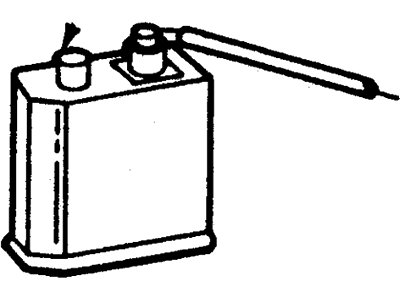

My Garage
My Account
Cart
Genuine Mercury Lynx Vapor Canister
Fuel Vapor Canister- Select Vehicle by Model
- Select Vehicle by VIN
Select Vehicle by Model
orMake
Model
Year
Select Vehicle by VIN
For the most accurate results, select vehicle by your VIN (Vehicle Identification Number).
2 Vapor Canisters found
Mercury Lynx Vapor Canister
We provide a wide range of Mercury Lynx Vapor Canister at the best prices possible. If you need Mercury Lynx Vapor Canister, you can shop with confidence on our website. All our OEM parts come with a manufacturer's warranty and are delivered to your door step with a fast delivery service.
Mercury Lynx Vapor Canister Parts Questions & Experts Answers
- Q: What is the function and service procedure for the fuel vapor recovery system,Canister Purge Valve and Vapor Canister on Mercury Lynx?A:This system is aimed at eliminating the chances of hydrocarbons-atto, which can be realeased to the atmosphere, with fuel vapour from the fuel tank and the carburetor or fuel injection system being stored in a capacitive canister from charcoal, before being conducted to the intake manifold or air cleaner to be burnt. Trash identified is consists of parts such as, charcoal canister, and the hoses interconnecting the fuel tank, filler tube and carburetor or the fuel injector. Fuel tank with a valve at the header is same containing the vapor until the engine fires up and then passes to a charcoal canister which is between the left front wheel and the bumper. In carbureted models it is a canister purge valve through which vapor is regulated from the canister to the intake manifold while in fuel injected models it is a canister purge solenoid electrically connected to the air cleaner housing. Fuel that would accumulate in the carburetor float bowl and act as a gonna reservoir is also vented to the charcoal canister in the off condition, but in the on condition a fuel bowl solenoid vent valve shuts it. When the engine compartment is cold, there is a thermal vent valve in the carburetor to the canister vent line which prevents fuel tank vapor from venting through the carburetor float bowl. Since the canister lacks moving parts, the canister should be visually inspected for loose, missing, or damaged fittings and replaced if needed. In the case of the carburetor equipped models the functionality of the canister purge valve is determined from its vacuum, while in the case of the fuel injected models, the functionality of the canister purge solenoid is checked by applying voltage. The carburetor fuel bowl solenoid vent valve and thermal vent valve are also checked for their proper working and the thermal vent valve has specific temperature particulars. Component replacement also includes identifying the canister and disconnecting it by removing hoses and bolts then replacing it in the reverse order again, for other components includes labeling the hoses, detaching them and then following the same procedure of installation as was followed during removal.




